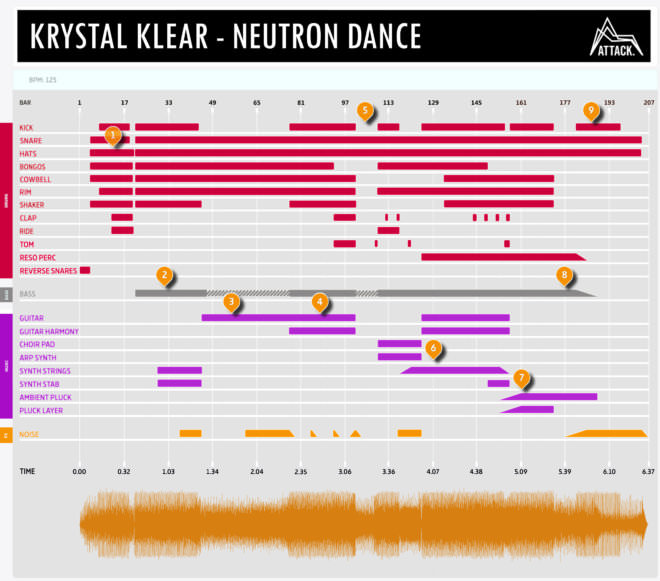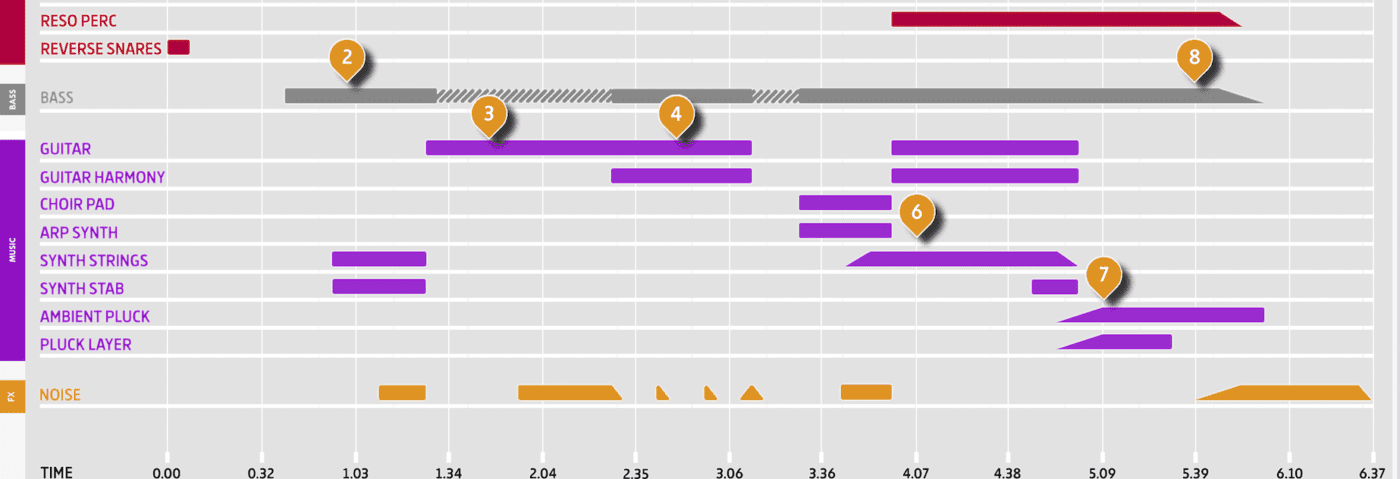In our latest Deconstructed we break down the arrangement to one of the most likeable tracks of the summer Krystal Klear’s ‘Neutron Dance’.
The track is a masterpiece in structural simplicity and melodic arrangements with some subtle additions to keep the listener glued.
It’s also worth listening to this live version on Pete Tong’s show from the end of July and to see the Krystal Klear studio check out our recent My Studio feature with him here.
The Track
THE ARRANGEMENT

WHAT’S HAPPENING?
- The track kicks off with a short burst of reverse snares leading to the initial groove of the cowbell, rimshot, bongos, shaker and snares. The percussion instruments are loosely programmed giving them groove with an organic feel. This can be easily achieved by nudging the hits left or right on the grid. The shaker is panned hard left and hard right every 16th note. A hi-hat and ride provide the top end and the sizzle in the drums. The hats have a small amount of stereo movement which gives extra space between the various drum sounds. The kick is a short sample in contrast to the big reverb snare and reminiscent of a big disco record which creates an intro that is instantly recognisable. An 808 clap and ride cymbal is introduced with a snare fill leading the transition to the next section.
- Everything remains whilst the synth bass is introduced with the resonance on the filter giving the sound a squelchy analog tone. The decay and sustain on the envelope is kept low to keep the notes short. The notes are playing 2 16th’s in each offbeat, and switching note every bar to create a 4 bar sequence. The bass riff is essentially quite simple which makes it memorable and easy to dance to. The track is in G Major, which alongside C Major is the most popular key signature in western music. Some panning synth stabs are introduced, providing a nice bit of ear candy and stereo movement and then we move into an interesting synth string sound that starts as a riser/uplifter and progresses into a held string. This string is mixed very low creating the necessary suspense before the breakdown, which is announced with a short FX sweep and snare fills
- The 32 bar breakdown. A high passed version of synth bass is kept in for the breakdown, which keeps the groove going and the energy up. The main lead is introduced, a catchy retro 80’s synth guitar which like the bass is playing a 4 bar sequence. The riff only changes with a pleasant resolve every 4th bar harmonising well with the bass synth. The kick drum drops out as the guitar carries the rhythm at this point with the cowbells continuing to drive a counter groove. The noise riser is filtered in and out eventually growing with a slow rise building up to the drop. The drop is teased at bar 69 but instead of the noise rising, it filters out instead leaving the hi-hats to drive the next 8 bars forward until the drop. The tease at bar 69 is a clever way to heighten the anticipation.
- For the first time, all the elements are played together. At this point the track is in full flow and there are only minor adjustments while the full arrangement is played for 24 bars. Towards the end of the section the bass filter is opened slightly to prepare for the next breakdown and the kick varies it’s rhythm towards the end of the 24 bar sequence to alert the audience a change is coming. The only music addition here is electronic tom drums playing from bar 93 as the bass resonance increases paving the way for the breakdown
- As the bass continues to filter we move through 8 bars of a pre build-up into the second build-up in the song. This one is slightly different to before. The kick drops out and the resonance is increased on the bass which reduces its lower frequencies. Some clever spot fills and in comes the choir pad and arpeggiator. The choir pad follows the bass notes whilst the sawtooth wave arpeggiator
is playing 16th notes, with 4 notes arpeggiating upwards each beat.The apprehension grows with the strings rising and holding a high note right at the top of the mix. The bass, kick and arpeggiator are all filtered out as the choir pad carries the melody with the melody strings. Lastly, all the sounds in the track cut out for one beat to make way for a solitary snare hit. This tiny, but important, section of silence heightens the impact of the drop when the main synth comes back in.
- At this point the full arrangement has returned. To make it sound bigger than the first chorus, and more uplifting, we have the synth strings holding a pedal note in the top register. This effect makes the spectrum sound complete. The ambient pluck is filtered into the arrangement. This pluck sound has the envelope open with significant and spacious reverb applied. The contrast between the sound design on this synth and the earlier staccato synths indicate a change in mood, mellowing things out and moving smoothly into the next section.
- This is an extension of the main theme but with the introduction of the ambient pluck the mood has changed. Rather than a sense of euphoria it feels like a release for the listener and takes us smoothly into the outro. The only new addition to the arangement is a harmonised pluck synth to the guitar with a warped effect but it is kept very low in mix and panned hard to the right.
- Now fully immersed in the outro, the bass and the guitar have dropped out. The ambient pluck is layered with another pluck playing the same riff. This approach to the outro, rather than simply fading or filtering out the main synth, sounds more fluid. The kick returns at bar 181 for 8 bars, whilst the rest of the music continues to filter out.
- The end is a reduced arrangment of the groove from the beginning of the track. It only has the noise FX, kick drum, hats and snare eventually ending with a delay on a pitched snare roll.
